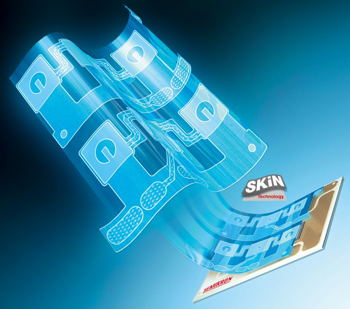Novel semiconductor packaging doubles current densities
The power semiconductor specialist Semikron has developed a novel packaging technology for power semiconductors which, it claims, will allow converter volumes to be reduced by 35%. The technology, called SKiN, removes the need for conventional bond wires, solders and thermal paste, and uses a system of flexible foils and sintered connections instead.

The new technology can achieve current densities of 3A/cm2 – twice as high as the 1.5A/cm2 achievable with standard wire-bonding technology. As well as delivering higher current-carrying capacities, this approach also produces a ten-fold increase in load-cycle capabilities.
For the past 25 years, wire bonding has been the main method of making chip top-side connections to direct-bonded copper (DBC) substrates. But this technology cannot meet the need for increasingly higher current densities, and can impair reliability.
In the new packaging process, a sintered foil replaces the wire bonding on the chips and the underside of the chip is sintered to the DBC. This results in a good thermal and electrical connection because the sintered layers have a lower thermal resistance than solder joints. The sintered foil connects the chip across its entire surface, unlike the bond wires which connect the chips at the contact points only.
The new technology’s high load-cycle capabilities allow higher operating temperatures – a growing requirement as the power semiconductor industry moves towards new materials such as silicon carbide (SiC) and gallium nitride (GaN), which operate at elevated temperatures.
As well as removing the need for wire bonding, the new packaging also avoids the use of solder thermal paste, which is responsible for around 30% of the thermal resistance in a system. By replacing it, the thermal conductivity between chip and heatsink is improved, resulting in a 30% increase in usable electric current.
The SKiN technology is expected to be particularly attractive for applications such as electric vehicles and wind turbines where space is an important factor. For example, the technology will allow a 3MW liquid-cooled wind power converter to fit inside one switching cabinet, while 90kW converters for hybrid and electric vehicles could be 35% smaller than the smallest converter on the market today.

